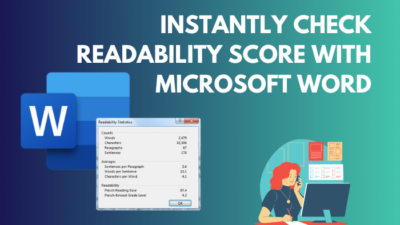In SharePoint, not every site you create is just for personal work or just for your team. There are times when you need to showcase your site to particular people. That’s where SharePoint Server Publishing Infrastructure comes into play.
When you activate the Publishing Infrastructure, you will be presented with a plethora of options and services. Is it also okay for you to turn it on?
This is a commonly asked subject, and in this article, I will go over the server Publishing infrastructure in SharePoint.
In SharePoint, server publishing infrastructure is a collection of Publishing site elements that can be obtained from a publishing site template. SP Server Publishing Infrastructure is an effective tool allowing businesses to create and manage exceptional websites on their own.
Utilizing this kind of framework, you can develop fluid sites that are easy to operate, aesthetically pleasing, and search engine friendly. You can additionally present the result while customizing the appearance and structure of your website, adding interactive features, and creating questionnaires and surveys to gather crucial data.
However, that’s not all, Server Publishing Infrastructure also includes excellent content administrative tools. You may create and organize material, schedule publication of content, and restrict individuals from having permission to view particular sections or content.
Server Publishing Infrastructure has you covered when you’re a small business owner trying to build an online presence or a huge enterprise in need of a complete content management solution.
With the Publish Infrastructure, you can publish any file or page to your SharePoint, which can be accessible by anyone with enough authorization.
You can easily develop a website that actually conveys the identity of your company and engages your audience through its intuitive overlap, strong features, and extensive customization possibilities.
Therefore, you know what it is, but let’s go into the specifics of what traits it provides when the functions are enabled. It’s an enticing way to speed up your process, but it might be unsettling for inexperienced users. Let’s now look at how to enable the functionality.
Just by activating the Publishing infrastructure at the site collection level, you can bring all the publishing options to the SharePoint site level. Now let’s activate the Publishing infrastructure in SharePoint.
Trigger Publishing Feature at the Site Collection Tier
- Go to SharePoint and while you are at the root of Site Collections, click on the cog wheel to bring settings.
- Select Site Settings.
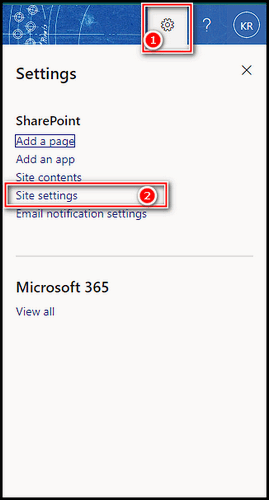
- Choose Site Collection Features from Site Collection Administration.
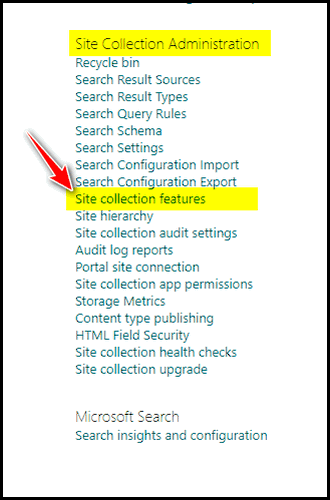
- Scroll down and locate the option SharePoint Server Publishing Infrastructure and click on Activate.
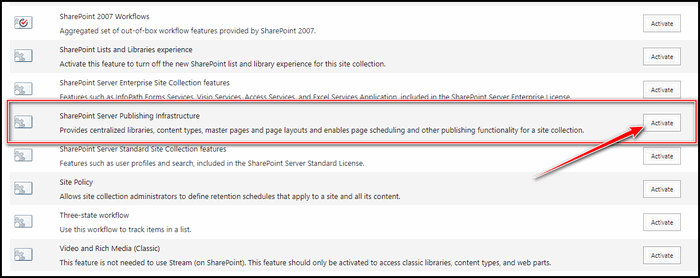
It will take some time to activate the option, so wait patiently. After the option is activated, you will find there are now two options – Deactivate and Active. Now let’s turn on the feature from Site Level.
Trigger Publishing Attribute at the Site Tier
- Click on the cog wheel or get into any site and then click on the cog wheel to bring the Settings.
- Choose Site Settings.

- Select the Manage site features from the Site Actions category.
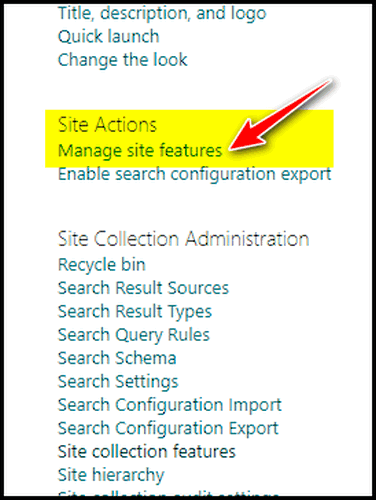
- Scroll down and find the option SharePoint Server Publishing and click on the Active button.

Note: Turn on the Site tier option after the Site Collection level, otherwise you will encounter the error message.
What are the Benefits of Publishing Features?
For an Intranet to be successful and appear professional, publishing features is significant. You may take use of a number of tools that can assist enhance the user experience as a whole and make managing your Intranet content simpler through the use of publishing options. The following are some primary benefits of publishing features.
Ability to inherit site theme & branding
With the help of publishing tools, you can establish a unified theme and identity for your intranet site. By doing this, you can make sure that the site’s pages all have a uniform appearance and feel, which improves the user experience as a whole.
Larger firms that need to preserve a consistent brand across several teams and departments will find this option useful.
You can design a more adaptable user interface to enhance your intranet site using publishing features. This may entail developing drop-down menus, breadcrumb navigation trails, and other structural components that facilitate users’ access to the data they require.
Individuals have no trouble finding the content they require using a more natural navigation system, which can boost productivity and teamwork.
Ability to move/copy sites and web parts around using the Content and Structure feature
The ability to relocate or replicate sites and web sections utilizing the Content and Structure feature is one of the key benefits of publishing features. Larger firms who are rearranging their intranet content or shifting material between multiple regions may find this to be especially helpful.
You can swiftly relocate site elements and material with this function, which helps to improve the efficiency of your content management procedures.
Advanced Wiki sites
Eventually, publishing abilities enable you to build advanced Wiki sites for teamwork and information sharing. Users can produce and edit material interactively on advanced Wiki sites, which can assist to build a community of sharing expertise and creativity inside your firm.
This is especially beneficial for teams working on projects together or communicating data across departments. Also, publishing can help a lot to monitor the repetitive/recurring task in SharePoint.
Ultimately, publishing tools provide a variety of perks that can enhance the user experience in general and make managing your Intranet content easier.
You may construct a more professional-looking Intranet site with features that are better to access, adaptable, and collaborative by utilizing publishing tools.
Is it Necessary for You to Turn On Publishing Features?
If you don’t use Sharepoint Sites to the utmost level, or you don’t code, or you don’t use 3rd party add-ons, then there is no need for you to utilize the SharePoint Publishing features. That’s why by default, Publishing features stay deactivated.
Triggering Publishing attributes has some benefits as well as some disadvantages. So, what are the disadvantages of Publishing features?
Publishing features can disable certain capabilities, such as the save site as a template function. The result can be problematic, especially if you want to construct a site layout for subsequent usage or for purposes of backup. When this function is hindered, you might want to find alternative ways to back up or copy your site.
Besides that, Publishing features make SharePoint harder to administrate. This is because Publishing features typically involve more complex settings and configurations than standard SharePoint features.
When your experience with SharePoint administration is low, it will feel much more challenging to configure these features correctly and ensure they are working properly.
It’s also crucial to consider the impact of publishing features on your users. Additional training is required for some publishing attributes, or support to help users understand how to use them effectively.
Obtaining benefits from the features is just out of imagination when your users don’t even know how to use publishing.
While publishing features can offer many benefits in terms of content creation and management, it’s important to carefully weigh the potential disadvantages and ensure that the benefits outweigh the costs for your specific use case.
In case you don’t need the publishing attributes, don’t use it. Not only it brings discomfort to you but also to your subordinates. However, when you know how to use it, you can utilize its fruitful features.
FAQs
What is server publishing infrastructure in SharePoint?
In SharePoint, server publishing infrastructure is an attribute set that offers a foundation for authoring, publishing, and managing information. It comes with tools and features for creating and releasing rich, fluid web pages with a unified look and feel.
What are some best practices for using SP server publishing infrastructure?
Best practices for using SharePoint publishing infrastructure include creating a consistent look and feel across all pages, using page layouts to standardize design, creating clear navigation structures, and using metadata and content types to manage content effectively.
How can I measure the effectiveness of my publishing infrastructure in SharePoint?
You can measure the effectiveness of your publishing infrastructure by tracking page views, engagement metrics, and other analytics. You can also solicit feedback from users to get a sense of how well your pages are meeting their needs.
Final Thoughts
Publishing infrastructure has so many features and benefits in Microsoft SharePoint. When you don’t have much experience with it, then it can be a nuisance cause it brings significant options.
However, Publishing infrastructure brings so many options and control to workflow, and with the help of that, you can take your productivity to the next level.



